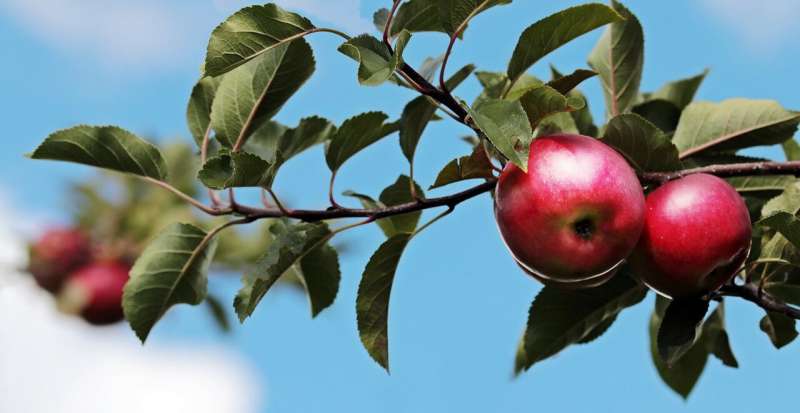This article has been reviewed according to Science X's editorial process and policies. Editors have highlighted the following attributes while ensuring the content's credibility:
fact-checked
peer-reviewed publication
trusted source
proofread
Flowering in 'Honeycrisp' apple shows that spurs are semiautonomous organs

Irregular flowering and biennial bearing are challenging in many apple (Malus × domestica) cultivars such as "Honeycrisp." Apple flowering is influenced by many factors including crop load, fruit weight, seed number, and bourse shoot length. However, it is unclear how these factors exert their control.
Flowering is a biologically and commercially important stage of apple tree development. In apple, flowers are usually formed on short shoots or spurs, and one or more buds in the axils of spur leaves may develop into bourse buds or bourse shoots. Flowers form within buds, overwinter, and emerge the following spring. One of the most challenging problems that apple growers face is biennial bearing. Biennial bearing is "the fluctuation in cropping from year-to-year caused by irregular flowering." Despite many years of research, biennial bearing remains a major challenge.
The role of seeds in biennial bearing of apple is established in the literature, but there are reasons to question this hypothesis. For example, although gibberellin (GA4 and GA7) activities have been identified in apple seeds in the early stages of fruit development, movement of gibberellins from seeds to bourse buds to inhibit flower formation has not been demonstrated.
Furthermore, while studies with parthenocarpic cultivars have pointed to a role of seeds, none of the major commercial apple cultivars are parthenocarpic (fruits that develop without fertilization of the ovule). Thus, caution should be used extrapolating results from parthenocarpic cultivars to commercially important, non-parthenocarpic cultivars
Researchers have investigated flowering in the Honeycrisp apple, and whether flower formation is regulated locally within the spur or if it is under the control of the whole tree system.
In 2013, flowering was affected by fruit number per tree, fruit number per spur and their interaction, and with lower total tree crop loads, spurs bearing two fruit had fewer flowers than those with a single fruit. In 2014, few spurs formed flowers regardless of treatment. In 2013, flowering was unaffected by seed number on single-fruited spurs but flowering inhibition was correlated with fruit weight. In spurs bearing two fruits, flowering was inhibited by higher seed numbers but fruit weight per spur had no effect on flowering.
The data suggest that both whole tree and within-spur characteristics contribute to local flower formation. Therefore, Honeycrisp spurs can be considered semi-autonomous organs because inhibition of flower formation appears to be related to the depletion of resources both locally within the spurs, and systematically within the whole tree. The main factors associated with flower formation were fruit number per tree, fruit number per spur, bourse shoot length, and bourse number per spur. In contrast to previous reports, the data show that seeds do not play a direct role in regulating flower formation.
In conclusion, the researchers suggest that Honeycrisp spurs are semiautonomous organs because spur characteristics such as fruit weight, fruit number, bourse number, and bourse weight affect flower formation on fruiting spurs under the influence of the year and the total fruit number per tree.
Moreover, inhibition of flower formation may be related to the depletion of resources both within the spurs and within the whole tree. Seeds do not play a direct or critical role inhibiting flower formation; however, they likely increase the demand of the fruit for different resources.
Studying differences in flower formation pathways among annual and biennial cultivars using different fruit numbers per tree and per spur could pave the way to further explain the irregularity in flower formation of biennial cultivars and explain the complicated networks involved in apple flower formation.
The study is published in the Journal of the American Society for Horticultural Science.
More information: Mokhles A. Elsysy et al, Flowering in 'Honeycrisp' Apple Shows That Spurs Are Semiautonomous Organs, Journal of the American Society for Horticultural Science (2023). DOI: 10.21273/JASHS05281-22
Journal information: Journal of the American Society for Horticultural Science
Provided by American Society for Horticultural Science





















